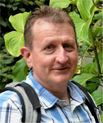Applying petrophysics and rock property modelling to enhance play-based assessments of the geological storage potential for carbon dioxide: western Eromanga Basin case study
Barry E. Bradshaw A * , Tom Bernecker A , Mavise Beattie B , Jeremy Iwanec C , Ray Spicer D , David Lund E and Ryan Owens AA
B
C
D
E

Barry Bradshaw is a Geoscientist with 33 years of experience undertaking regional geological and geophysical studies and play-based resource assessments for hydrocarbon resources and geological storage projects. Barry is currently employed as the Energy Resources and Advice Activity Leader at Geoscience Australia, and he has previously worked as a Principal Geologist at CGSS consultants, a Senior Research Scientist at the Australian Geological Survey Organisation/Geoscience Australia, and a Research Scientist at Texas A&M University (USA). Barry graduated from the University of Sydney in 1988 and completed a PhD in Earth Sciences at the University of Waikato (New Zealand) in 1991. |

Thomas (Tom) Bernecker is a Geoscientist who holds an MSc from the University of Aachen, Germany, and a PhD from La Trobe University, Melbourne. His early geological work involved the development of models for siliciclastic and carbonate depositional systems in northwestern Europe and in Australia. After a lectureship at the University of Melbourne, Tom joined the Victorian Department of Natural Resources and Energy where his work focused on the hydrocarbon prospectivity of the Gippsland and Otway basins. Tom joined Geoscience Australia in 2007 and is currently the Director of Energy Resources Advice and Promotion. |

Mavise Beattie is a seasoned Geoscientist with over 20 years of global experience in the oil and gas industry, holding a PhD from the University of Wollongong. Her career began with Shell as a Sedimentologist/Reservoir Geologist, and she has since worked with prominent companies like Oil Search, INPEX, KUFPEC, Drillsearch Energy, Santos, Geoscience Australia and, currently, ADZ Energy. Mavise has contributed to significant projects across various regions, including Borneo (Malaysia), Papua New Guinea (PNG), Australia, the Philippines and Alaska. Her expertise spans reservoir modelling, field development, well planning, resource and reserves assessment, assurance, project management and team leadership. |

Jeremy Iwanec is a Geoscientist with 21 years of petroleum industry experience. He completed a BSc (Honours) in Applied Geology from the University of New South Wales in 2002 before joining Oil Search Limited in 2003. At Oil Search, he worked on various projects across PNG, Yemen and Kurdistan, specialising in play-based exploration, 2D and 3D seismic interpretation, structural and stratigraphic modelling, well planning and delivery, and resource assessments. In 2021, Jeremy joined Geoscience Australia where he conducted studies of sediment-hosted energy resources through geological modelling and play-based mapping. In 2024, Jeremy began working with the NSW Department of Climate Change, Energy, the Environment and Water, focusing on long-duration energy storage technologies. |

Ray Spicer gained his qualifications from the National Centre for Petroleum Geology and Geophysics and the University of Adelaide. His experience has been gained in all aspects of petrophysics, including new ventures, exploration, appraisal, development and abandonment. As well as working within the majority of both onshore and offshore Australian basins he has also worked on, or had exposure to, basins in PNG, New Zealand, the Middle East and North Africa, Southeast Asia and the Former Soviet Union. |

David Lund is a Development Geologist with over 25 years of petroleum industry experience. He joined Horizon in 2023, working the company's China and Australian assets. Prior to joining Horizon, David was a Geological Advisor with Oil Search, working extensively on the PNG oil and gas fields, and as an Energy Resources Assessment Geoscientist with Geoscience Australia. |

Ryan Owens is an Energy Resources Geoscientist in the Energy Resources and Advice team at Geoscience Australia. He graduated from the Australian National University (ANU) in 2007 with a BSc in Geology (Honours). Subsequently, he worked in mineral exploration before undertaking further studies in paleoceanography at the Research School of Earth Sciences, ANU. Ryan joined Geoscience Australia in 2014 through the graduate program and has contributed to a variety of projects, including the northern Houtman Sub-basin prospectivity study, the Geological and Bioregional Assessment Program and Offshore Acreage Releases. |
Abstract
Identifying basin areas that are prospective for the geological storage of carbon dioxide (GSC) is essential to support Australia’s transition to a net-zero emissions energy future. Geoscience Australia has developed a play-based common risk segment (CRS) mapping approach to evaluate GSC prospectivity based on four geological risk elements: (1) injectivity, (2) storage effectiveness, (3) containment and (4) structural complexity. Various geological criteria are used to evaluate these risk elements using post-drill data/analysis, gross depositional environment (GDE) maps, rock property maps, and depth structure and isochore maps. Rock property maps form an essential component in defining the CRSs for GSC prospectivity maps. This paper provides a case study from Geoscience Australia’s assessment of the GSC potential for the western Eromanga Basin (WEB). Rock property maps are constructed in the Petrel Software Platform (©SLB). Inputs for these models include a 3D structural model incorporating 14 play intervals, GDE maps and sub-surface rock properties derived from petrophysical analyses of wireline log data (such as volume of clay/shale, total and effective porosity, Timur-Coates permeability and apparent water salinity). Key outputs from the geological model include permeability thickness (used to assess injectivity), effective porosity (used together with depth structure maps to assess storage effectiveness), and net seal thickness (used to assess containment). Results from the CRS mapping show the WEB has potential to support industrial-scale (>1 mtpa) GSC projects using migration assisted storage in structurally simple areas where there is favourable stacking of effective reservoirs overlain by impermeable seals.
Keywords: common risk segment maps, effective porosity, geological model, geological storage of carbon dioxide, permeability thickness, petrophysics, play-based assessments, rock property maps.
 Barry Bradshaw is a Geoscientist with 33 years of experience undertaking regional geological and geophysical studies and play-based resource assessments for hydrocarbon resources and geological storage projects. Barry is currently employed as the Energy Resources and Advice Activity Leader at Geoscience Australia, and he has previously worked as a Principal Geologist at CGSS consultants, a Senior Research Scientist at the Australian Geological Survey Organisation/Geoscience Australia, and a Research Scientist at Texas A&M University (USA). Barry graduated from the University of Sydney in 1988 and completed a PhD in Earth Sciences at the University of Waikato (New Zealand) in 1991. |
 Thomas (Tom) Bernecker is a Geoscientist who holds an MSc from the University of Aachen, Germany, and a PhD from La Trobe University, Melbourne. His early geological work involved the development of models for siliciclastic and carbonate depositional systems in northwestern Europe and in Australia. After a lectureship at the University of Melbourne, Tom joined the Victorian Department of Natural Resources and Energy where his work focused on the hydrocarbon prospectivity of the Gippsland and Otway basins. Tom joined Geoscience Australia in 2007 and is currently the Director of Energy Resources Advice and Promotion. |
 Mavise Beattie is a seasoned Geoscientist with over 20 years of global experience in the oil and gas industry, holding a PhD from the University of Wollongong. Her career began with Shell as a Sedimentologist/Reservoir Geologist, and she has since worked with prominent companies like Oil Search, INPEX, KUFPEC, Drillsearch Energy, Santos, Geoscience Australia and, currently, ADZ Energy. Mavise has contributed to significant projects across various regions, including Borneo (Malaysia), Papua New Guinea (PNG), Australia, the Philippines and Alaska. Her expertise spans reservoir modelling, field development, well planning, resource and reserves assessment, assurance, project management and team leadership. |
 Jeremy Iwanec is a Geoscientist with 21 years of petroleum industry experience. He completed a BSc (Honours) in Applied Geology from the University of New South Wales in 2002 before joining Oil Search Limited in 2003. At Oil Search, he worked on various projects across PNG, Yemen and Kurdistan, specialising in play-based exploration, 2D and 3D seismic interpretation, structural and stratigraphic modelling, well planning and delivery, and resource assessments. In 2021, Jeremy joined Geoscience Australia where he conducted studies of sediment-hosted energy resources through geological modelling and play-based mapping. In 2024, Jeremy began working with the NSW Department of Climate Change, Energy, the Environment and Water, focusing on long-duration energy storage technologies. |
 Ray Spicer gained his qualifications from the National Centre for Petroleum Geology and Geophysics and the University of Adelaide. His experience has been gained in all aspects of petrophysics, including new ventures, exploration, appraisal, development and abandonment. As well as working within the majority of both onshore and offshore Australian basins he has also worked on, or had exposure to, basins in PNG, New Zealand, the Middle East and North Africa, Southeast Asia and the Former Soviet Union. |
 David Lund is a Development Geologist with over 25 years of petroleum industry experience. He joined Horizon in 2023, working the company's China and Australian assets. Prior to joining Horizon, David was a Geological Advisor with Oil Search, working extensively on the PNG oil and gas fields, and as an Energy Resources Assessment Geoscientist with Geoscience Australia. |
 Ryan Owens is an Energy Resources Geoscientist in the Energy Resources and Advice team at Geoscience Australia. He graduated from the Australian National University (ANU) in 2007 with a BSc in Geology (Honours). Subsequently, he worked in mineral exploration before undertaking further studies in paleoceanography at the Research School of Earth Sciences, ANU. Ryan joined Geoscience Australia in 2014 through the graduate program and has contributed to a variety of projects, including the northern Houtman Sub-basin prospectivity study, the Geological and Bioregional Assessment Program and Offshore Acreage Releases. |
References
Ambrose GJ, Scardigno M, Hill AJ (2007) Petroleum geology of the Middle–Late Triassic and Early Jurassic sequences in the Simpson Basin and northern Eromanga Basin of central Australia. The APPEA Journal 47(1), 127-143.
| Crossref | Google Scholar |
Bernecker T, Bradshaw BE, Iwanec J, Bradey K, Owens R (2024) Regional geology of the Pedirka and western Eromanga basins. Australia’s Future Energy Resources (AFER) Project, Exploring For The Future Program. (Geoscience Australia) 10.26186/149701
Boult PJ (1993) Membrane seals and tertiary migration pathways in the Bodalla South oilfield, Eromanga Basin, Australia. Marine and Petroleum Geology 10, 3-13.
| Crossref | Google Scholar |
Bradshaw J, Bradshaw BE, Allinson G, Rigg A, Nguyen G, Spencer L (2002) The potential for geological sequestration of CO2 in Australia: preliminary findings and implications for new gas field development. The APPEA Journal 42, 25-46.
| Crossref | Google Scholar |
Bradshaw BE, Spencer LK, Lahtinen AC, Khider K, Ryan DJ, Colwell JB, Chirinos A, Bradshaw J (2009) ‘Queensland Geological Storage Atlas.’ (Compiled by Greenhouse Gas Storage Solutions on behalf of Queensland Department of Employment, Economic Development and Innovation) Available at https://geoscience.data.qld.gov.au/dataset/ds000035
Bradshaw BE, Rollet N, Iwanec J, Bernecker T (2022) A regional chronostratigraphic framework for play-based resource assessments in the Eromanga Basin. The APPEA Journal 62, 392-399.
| Crossref | Google Scholar |
Bradshaw BE, Wainman C, Ferdinando D, Furnass M, O’Leary R, Hostetler S, Orr M, Rees S, Mezzomo S, Woods M, McAlpine S (2023) Geological storage of carbon dioxide: Eromanga Basin, Trusted Environmental and Geological Information Program. (Geoscience Australia and CSIRO: Australia) 10.26186/147561
Bradshaw BE, Iwanec J, Beattie M, Bernecker T, Evans T, Lund D (2024a). ‘Assessment of the Geological Storage Potential for Carbon Dioxide: Pedirka and western Eromanga basins. Australia’s Future Energy Resources (AFER) Project.’ Record 2024/30. (Geoscience Australia: Canberra, ACT) Available at http://pid.geoscience.gov.au/dataset/ga/149622
Bradshaw BE, Iwanec J, Doig A, Strong P, Bernecker T (2024b). A geological framework to support play-based resource assessments in the Pedirka and Simpson basins. In ‘Proceedings of the Petroleum Exploration Society of Australia, vol. 2’. CABS IV Special Publication. pp. 145–157. 10.36404/OJTN5102
Bump AP, Bakhshian S, Ni H, Hovorka SD, Dunlap D, Olariu M, Hosseini S, Meckel TA (2023) Composite confining systems: rethinking geological seals for permanent CO2 sequestration. International Journal of Greenhouse Gas Control 126, 1-12.
| Crossref | Google Scholar |
DISR (2024) Commonwealth of Australia Future Gas Strategy Analytical Report. (Department of Industry, Science and Resources) Available at https://www.industry.gov.au/sites/default/files/2024-05/future-gas-strategy-analytical-report.pdf
Evans T, Bradshaw BE, Beattie M (2024) Summary of hydrogeology: Pedirka and Western Eromanga Basins. Australia’s Future Energy Resources (AFER) Project, Exploring For The Future Program. (Geoscience Australia: Canberra, ACT) 10.26186/149702
Furnass M, Wainman C, Bradshaw BE, O’Leary R, Ferdinando D, Hostetler S, Orr M, Rees S, Mezzomo S, Woods M, McAlpine S (2023) ‘Geological storage of carbon dioxide: North Bowen Basin, Trusted Environmental and Geological Information Program.’ (Geoscience Australia and CSIRO: Australia) 10.26186/147506
Hoffman N, Carman G, Bagheri M, Goebel T (2015) Site characterisation for carbon sequestration in the nearshore Gippsland Basin. The Carbon Net Project. AAPG SEG International Conference and Exhibition, pp. 13–16, September 2015, Melbourne, Australia. (Society of Exploration Geophysicists) 10.1190/ice2015-2209980
IPCC (2022) Climate Change 2022: Mitigation of Climate Change. In ‘Contribution of Working Group III to the Sixth Assessment Report of the Intergovernmental Panel on Climate Change’. (Eds PR Shukla, J Skea, R Slade, A Al Khourdajie, R van Diemen, D McCollum, M Pathak, S Some, P Vyas, R Fradera, M Belkacemi, A Hasija, G Lisboa, S Luz, J Malley), pp. 3–48. (Cambridge University Press: UK) 10.1017/9781009157926.001
Iwanec J, Strong P, Bernecker T (2023) Underexplored but not forgotten: assessing the energy resources potential of the greater Pedirka region through play-based mapping. The APPEA Journal 63(S1), 251-256.
| Crossref | Google Scholar |
Iwanec J, Lund D, Bradshaw BE, Bradey K (2024a) ‘Pedirka and Western Eromanga Basins Depth and Isochore Maps - Data Package and Explanatory notes.’ (Geoscience Australia: Canberra, ACT) 10.26186/149124
Iwanec J, Bradshaw BE, Bernecker T, Doig A, Ferdinando D, Jarrett A, Strong P, Yarmohammadtooksi Z (2024b) Post-drill analysis to assess the prospectivity and geological risks for energy resources in the Pedirka, Simpson and western Eromanga basins. In ‘Proceedings of the Petroleum Exploration Society of Australia, vol. 2’. CABS IV Special Publication. pp. 158–172. 10.36404/CZAN6731
Keppel MN, Karlstrom KE, Love AJ, Priestley S, Wohling D, De Ritter S-J (2013) ‘Allocating Water and Maintaining Springs in the Great Artesian Basin, Volume I: Hydrogeological Framework of the Western Great Artesian Basin.’ (National Water Commission: Canberra) Available at https://cdn.environment.sa.gov.au/landscape/docs/saal/awmsgab-volume-i.pdf
Lane J, Greig C, Garnett A (2021) Uncertain storage prospects create a conundrum for carbon capture and storage ambitions. Nature Climate Change 11, 925-936.
| Crossref | Google Scholar |
Longley IM, Brown J (2016) Why bother? (with play based exploration): The five reasons why play based exploration is worthwhile in a modern busy understaffed and overworked exploration company environment. In ‘Oral presentation given at AAPG/SEG International Conference and Exhibition’. Melbourne 13–16 September 2015. AAPG Search and Discovery Article, p. 110227. (AAPG) Available at https://www.searchanddiscovery.com/pdfz/documents/2016/110227longley/ndx_longley.pdf.html
Middleton MF, Barker CE, Heugh J (2007) The geology of the western part of the Pedirka Basin, Australia. In ‘Proceedings of the Central Australian Basins Symposium, Alice Springs, Northern Territory, 16–18 August, 2005’. Eds. TJ Munson, GJ Ambrose. Special Publication 2. pp. 409–426. (Northern Territory Geological Survey) Available at https://geoscience.nt.gov.au/gemis/ntgsjspui/handle/1/81567
Munson TJ, Ahmad M (2013) Chapter 38 – Pedirka Basin. In ‘Geology and Mineral Resources of the Northern Territory’. (Compilers M Ahmad, TJ Munson). Special Publication 5. (Northern Territory Geological Survey) Available at https://geoscience.nt.gov.au/gemis/ntgsjspui/handle/1/81486
O’Brien G, de Morton S, Bason D (2024) Securing the Australian CCS project rollout by improving aspects of the GHG storage legislation: a discussion paper. Australian Energy Producers Journal 64(1), 13-23.
| Crossref | Google Scholar |
O’Leary R, Wainman C, Bradshaw BE, Furnass M, Ferdinando D, Hostetler S, Orr M, Rees S, Mezzomo S, Woods M, McAlpine S (2023) Geological storage of carbon dioxide: Cooper Basin, Trusted Environmental and Geological Information Program. (Geoscience Australia and CSIRO: Australia) 10.26186/147511
Passmore VL (1989) Petroleum accumulations of the Eromanga Basin: a comparison with other Australian Mesozoic accumulations. In ‘Proceedings of the Petroleum Exploration Society of Australia. The Cooper and Eromanga Basins, Australia, 1989’. (Ed. BL O’Neil). pp. 371–389. (Petroleum Exploration Society of Australia)
Spencer LK, Bradshaw J, Bradshaw BE, Lahtinen A, Chirinos A (2011) Regional storage capacity estimates: prospectivity not statistics. Energy Procedia 4(2011), 4857-4864.
| Crossref | Google Scholar |
Spicer R, Yarmohammadtooski Z, Lund D, Beattie M, Iwanec J (2024) The Pedirka and western Eromanga basins well log petrophysics data package, metadata statement. (Geoscience Australia: Canberra, ACT) Available at http://pid.geoscience.gov.au/dataset/ga/149208
Wainman C, Ferdinando D, Bradshaw BE, Furnass M, O’Leary R, Hostetler S, Orr M, Rees S, Mezzomo S, Woods M, Bouma M, McAlpine S (2023) ‘Geological storage of carbon dioxide: Galilee Basin. Trusted Environmental and Geological Information Program.’ (Geoscience Australia and CSIRO: Australia) 10.26186/147509
Wecker HRB (1989) The Eromanga Basin. The APPEA Journal 29(1), 379-397.
| Crossref | Google Scholar |


